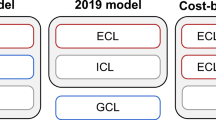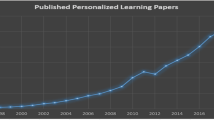Abstract
Recently, there has been a transition from traditional paper or computer-based learning environments to smartpad-based learning environments, which are based on touch and involve various cognitive strategies such as touch operation and note taking. Accordingly, the use of smartpads can provide an effective learning environment through cross-modality, which simultaneously integrates information using two or more sensory modalities. Based on this rationale, this study investigated the effects of cross-modality (vision and tactility) on knowledge acquisition in a smartpad-based learning environment. Interaction between different modalities and learners’ self-regulated learning (SRL) skills was also tested. Ninety-nine college students were randomly assigned to three different learning environments: paper-based, smartpad-based unimodal, and smartpad-based cross-modal environments. Students were differentiated according to high and low SRL skill levels. The findings suggest that the participants in the smartpad-based cross-modal environment significantly outperformed the participants in the smartpad-based unimodal environment pertinent to identification and comprehension knowledge acquisition. Furthermore, the participants in the smartpad-based cross-modal environment performed equally with the participants in the paper-based environment.








Similar content being viewed by others
References
Ausubel, D. P. (1962). A subsumption theory of meaningful verbal learning and retention. The Journal of General Psychology, 66(2), 213–224. doi:10.1080/00221309.1962.9711837.
Azevedo, R., & Cromley, J. G. (2004). Does training of self-regulated learning facilitate students’ learning with hypermedia? Journal of Educational Psychology, 96(3), 523–535. doi:10.1037/0022-0663.96.3.523.
Bansavich, J. C. (2010). iPad study at USF. Retrieved September, 5(201), pp. 1–30. Retrieved from http://ipad.wiki.usfca.edu/file/view/iPad+Study+at+USF+Report.pdf
Byun, H., Ryu, J., & Song, Y. (2011). Research trends on digital textbook and meta-analysis on its academic achievement. The Korean Journal of Educational Methodology Studies, 23(3), 635–663.
Calvert, G. A. (2001). Crossmodal processing in the human brain: insights from functional neuroimaging studies. Cerebral Cortex, 11(12), 1110–1123. doi:10.1093/cercor/11.12.1110.
Chan, M. S., & Black, J. B. (2006). Direct-manipulation animation: Incorporating the haptic channel in the learning process to support middle school students in science learning and mental model acquisition. In Proceedings of the 7th international conference on Learning sciences (pp. 64–70). Mahwah, NJ: LEA.
Chou, P. N., & Hsiao, H. C. (2010). The effect of varied visual scaffolds on engineering students’ online reading. Interdisciplinary Journal of E-learning and learning objects, 6(1), 193–201.
Clark, R. C., & Mayer, R. E. (2016). E-learning and the science of instruction: Proven guidelines for consumers and designers of multimedia learning (4th ed.). San Francisco, C: Wiley.
Cooley, H. R. (2004). It’s all about the fit: The hand, the mobile screenic device and tactile vision. Journal of Visual Culture, 3(2), 133–155. doi:10.1177/1470412904044797.
Corno, L., & Mandinach, E. B. (1983). The role of cognitive engagement in classroom learning and motivation. Educational Psychologist, 18(2), 88–108. doi:10.1080/00461528309529266.
Dickinson, D. (1995). Multimedia myths. Australian Personal Computer, 16(10), 144–145.
Dwyer, F. M. (1970). Exploratory studies in the effectiveness of visual illustrations. Audio-Visual Communication Review, 18(3), 235–249. doi:10.1007/BF02768497.
Dwyer, F. M. (1978). Strategies for improving visual learning. State College, PA: Learning Services.
Dwyer, F. M. (1994). One dimension of visual research: A paradigm and its implication. In D. Moore & F. Dwyer (Eds.), Visual learning: A spectrum of visual learning. New Jersey: Educational Technology Publications.
Dwyer, F. M., & Lamberski, R. J. (1977). The human heart: Parts of heart, circulation of blood and cycle of blood pressure. Lecture handouts, Department of Learning and Performance Systems, Pennsylvania State University, Lehman, PA.
Gibson, J. J. (1966). The senses considered as perceptual systems. Boston: Houghton-Miffin.
Ha, H. S. (2015). Pattern of media use by graduate students. KISDI STAT Report, 15(14), 1–17.
Harskamp, E. G., Mayer, R. E., & Suhre, C. (2007). Does the modality principle for multimedia learning apply to science classrooms? Learning and Instruction, 17, 465–477. doi:10.1016/j.learninstruc.2007.09.010.
Jeong, H. (2012). A comparison of the influence of electronic books and paper books on reading comprehension, eye fatigue, and perception. The Electronic Library, 30(3), 390–408. doi:10.1108/02640471211241663.
Kang, Y. Y., Wang, M. J., & Lin, R. (2009). Usability evaluation of E-books. Displays, 30(2), 49–52. doi:10.1016/j.displa.2008.12.002.
Kauffman, D. F. (2004). Self-regulated learning in web-based environments: Instructional tools designed to facilitate cognitive strategy use, metacognitive processing, and motivational beliefs. Journal of Educational Computing Research, 30(1), 139–161. doi:10.2190/AX2D-Y9VM-V7PX-0TAD.
Lee, H. W. (2015). Does touch-based interaction in learning with interactive images improve students’ learning? The Asia-Pacific Education Researcher, 24(4), 731–735.
Lee, H. W., Lim, K. Y., & Grabowski, B. L. (2010). Improving self-regulation, learning strategy use, and achievement with metacognitive feedback. Educational Technology Research and Development, 58(6), 629–648. doi:10.1007/s11423-010-9153-6.
Mihem, W. D. (1996). Interactivity and computer based instruction. Journal of Educational Technology, 24(3), 225–233. doi:10.2190/9V8J-48TX-461C-DXVG.
O’Hare, J. J. (1991). Perceptual integration. Journal of the Washington Academy of Sciences, 81(1), 44–59.
Pintrich, P. R. (2000). The role of goal orientation in self-regulated learning. In M. Boekaers, P. R Pintrich, & M. Zeidner (Eds.), Handbook of self-regulation (pp. 452–502). Burlington, MA: Elsevier Academic Press. doi: 10.1016/B978-012109890-2/50043-3
Pintrich, P. R., & De Groot, E. V. (1990). Motivational and self-regulated learning components of classroom academic performance. Journal of Educational Psychology, 82(1), 33–40. doi:10.1037/0022-0663.82.1.33.
Pintrich, P. R., Smith, D. E., Garcia, T, & McKeachie, W. (1991). A manual for the use of the motivated Strategies for learning Questionnaire (MSLQ). National Center for Research to Improve Postsecondary Teaching and learning, University of Michigan (ERIC Document Reproduction Service No. ED416830).
Reiser, R. A. (1994). Clark’s invitation to the dance: an instructional designer’s response. Educational Technology Research and Development, 42(2), 45–48. doi:10.1007/BF02299091.
Richey, R. C., Klein, J. D., & Tracey, M. W. (2011). The instructional design knowledge base: Theory, research, and practice. New York: Routledge.
Rodicio, H. G., Sánchez, E., & Acuňa, S. R. (2013). Support for self-regulation in learning complex topics from multimedia explanations: Do learners need extensive or minimal support? Instructional Science, 41(3), 539–553. doi:10.1007/s11251-012-9243-4.
Savas, P. (2014). Tablet PCs as instructional tools in English as a foreign language education. TOJET: The Turkish Online Journal of Educational Technology, 13(1), 217–222.
Schmidt-Weigand, F., Kohnert, A., & Glowalla, U. (2010). A closer look at split visual attention in system and self-paced instruction in multimedia learning. Learning and Instruction, 20(2), 100–110. doi:10.1016/j.learninstruc.2009.02.011.
Shaer, O., & Hornecker, E. (2010). Tangible user interfaces: past, present and future directions. Foundations and Trends in HCI, 3(1–2), 1–138. doi:10.1561/1100000026.
Thoermer, A., & Williams, L. (2012). Using digital texts to promote fluent reading. The reading teacher, 65(7), 441–445. doi:10.1002/TRTR.01065.
Wittrock, M. C. (1992). Generative learning process of the brain. Educational Psychologist, 27(4), 531–541.
Yukselturk, E., & Bulut, S. (2007). Predictors for student success in an online course. Educational Technology & Society, 10(2), 71–83.
Yun, H. J., & Moon, S. C. (2012). Factors affecting intension to use table PCs: moderating effects of smart phone use. Journal of broadcasting research, 79, 169–202.
Zimmerman, B. J. (1990). Self-regulated learning and academic achievement: an overview. Educational Psychologist, 25(1), 3–17. doi:10.1207/s15326985ep2501_2.
Acknowledgement
This research was supported by a 2015 Research Grant from Sangmyung University.
Author information
Authors and Affiliations
Corresponding author
Ethics declarations
Conflict of interest
The authors declare that they have no conflict of interest.
Rights and permissions
About this article
Cite this article
Lee, H.Y., Lee, H.W. The effects of cross-modality and level of self-regulated learning on knowledge acquisition with smartpads. Education Tech Research Dev 66, 247–265 (2018). https://doi.org/10.1007/s11423-017-9543-0
Published:
Issue Date:
DOI: https://doi.org/10.1007/s11423-017-9543-0




